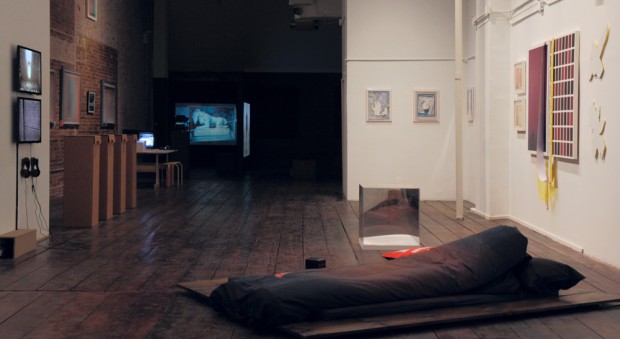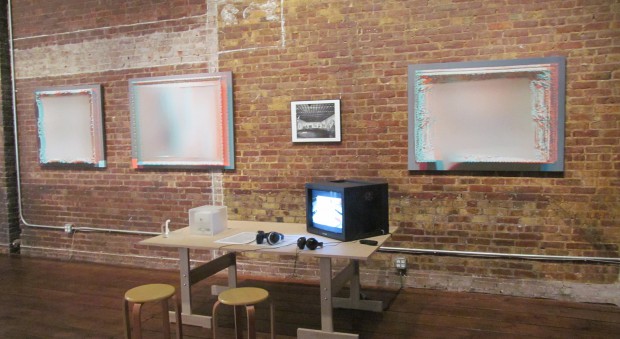
Installation view of the 2013 Whitney ISP Studio Exhibition, "The Passage of a Few Persons Through a Rather Brief Unity of Time." Photo courtesy: Whitney ISP.
The Whitney Independent Study Program might best be described as critical theory bootcamp. After nine months of attending rigorous seminars, each year’s 15 studio participants then put on an exhibition of new work. The expectation here is that an intense studio atmosphere squeezes out quality through pressure, like diamonds out of coal.
That works well for rocks, but less so for art. Months of theory tends to produce art that’s about theory; that’s not much of a transformation. For that reason, my expectations going into the 2013 Whitney ISP studio exhibition, The Passage of a Few Persons Through a Rather Brief Unity of Time, were low. Instead, I saw a fair amount of work that took our current financial crises to task, and examined its effects on a personal level. These works were, in a word, relevant.
The strongest had much to say, but within limited means. On the first floor, Constantina Zavitsanos’ It was what I wanted now was nearly invisible, just a child-sized stack of xeroxed papers off against the wall. Four- and five-digit-long numbers were printed across the papers, the numbers tracking Zavitsanos’ projected student loan debt over the next 25 years and the minimum income necessary to make monthly loan payments. It was a cut-and-dry monument to the standard student loan contract. We sign our names, and our futures, off to loan companies because we just can’t see or feel how much of a burden that’ll be in the future. That’s not a good sales strategy, but if a loan officer handed me thousands of pages showing my future indebtedness, I might’ve rethought signing away my future.

Adelita Husni-Bey in collaboration with Danilo Correale, "The Day After", 31 minutes, looped, HD Video.
What can’t be learned from our mistakes is how to cope with the global financial burden. Adelita Husni-Bey’s video The Day After documents individuals living off the grid, stocking up canned goods in bunkers, and communicating with extraterrestrials. Of the half dozen or so interviewees, my favorites were the woman who talks about joining a modern day forest tribe, whose self-sufficient members wear animal skin loincloths, and the artist who regaled tales of his “celestial sculpture” to attract UFOs. There’s one lesson to take from this video: in our new reality, there’s no one right way to deal. Husni-Bey’s great at letting her interviewees do all the talking, which is atypical for documentaries; there’s no Ken Burns chatter to add a historical layer. Instead, we just get to watch the interviewees’ lives unfurl as they discuss the “fate of our universe” when “we’ve spent all the money we have”.

Joao Enxuto and Erica Love, "Anonymous Painting" series and "Art Project 2023". Includes Ezra Stoller's black-and-white photograph "Whitney Museum, Marcel Breuer, New York, NY, 1966".
While most of the works in the show examined what’s happening in the world right now, at least one tackled the future. Joao Enxuto and Erica Love’s Art Project 2013 and Art Project 2023 a series of 3D paintings, video, and corporate-sounding narrative that playfully, humorously re-imagines a new future for the Whitney Museum’s Breuer building, as the Google Art Project Museum after a new global financial crisis in 2020. One small excerpt about this museum that requires visitors to wear Google Glass:
The flexibility of Art Project is unprecedented. For instance, if a couple visits the museum, they no longer need to agree on anything. One can ask a Scholar for a custom selection of 20th century monochrome paintings while their partner can default to comfortable results derived from data-mining and machine learning. Sharing results can often clutter the Google Glass…as with the recent craze in Felix Gonzales-Torres candy piles.
The story’s great, and full of dry humor; I recommend reading the full script here. Without letting on too much, let’s just say it ends badly, with virtual paintings in the Whitney Museum—now the Google Art Project Museum—combusting. The files deteriorates as the Google Glass-less minions watch in horror and awe from across Madison Avenue.
That’s where the 3D paintings come into play in the installation; they’re inkjet-printed paintings of images downloaded from Google Art Project. These Anonymous Paintings are intentionally blurred out, according to the artists, because of “copyright restrictions”. Putting on 3D glasses doesn’t help, they just make the paintings even blurrier. It’s one big fail for art and tech, but I do like these paintings because they conform to the rules of Google (they’ve got to be blurred out, and wearing glasses makes them better) more than the rules of art.
The moral of Joao Enxuto and Erica Love’s installation isn’t entirely clear, and I’m fine with that. They’re problem-solving through art, figuring out what the museum of the future might look like based on the current financial picture. That’s no easy task, so it’s good we have two oracles to let us know what’s in store.


Comments on this entry are closed.